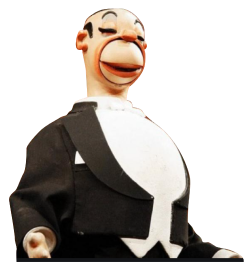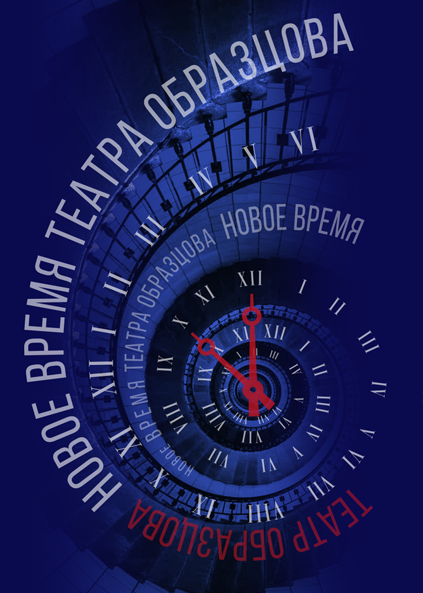Sergey Vladimirovich Obraztsov
SERGEY VLADIMIROVICH OBRAZTSOV
1901 - 1992
Sergey Obraztsov's creative journey began with a funny puppet named Bibabo from a Japanese goods store. It was given to little Seryozha by his mother. This puppet was a quite simple one- consisted of a head with a hole at the bottom (so that you can put it on your finger) and a rag robe. Obraztsov fell in love with Bibabo so much that he practically never parted with the puppet. During walks, he would put it on his hand and acted out scenes. Such little shows ware very amusing to random passers-by ...
Sergey Obraztsov was born on July 5, 1901 in Moscow in the family of an academician and a teacher. Upon graduation from the Realschule of K.P. Voskresensky, Sergey Obraztsov became a student of the Higher Art and Theatre Workshops («Vkhutemas»), where first he studied at the graphic arts and later at the painting faculty. Famous artists Abram Arkhipov and Vladimir Favorsky were his masters. He studied vocals at the school-conservatory of A. Sсhor.
In 1922, Obraztsov passed a competition and became an actor of the experimental Music studio of the Moscow Art Theater headed by Vladimir Nemirovich-Danchenko. Once Obraztsov was supposed to play the role of an old man in a play by Nemirovich-Danchenko. However, being a young man, he could not succeed in senile movements and intonations. Obraztsov did manage to find a way out - he made a puppet of an old man and put this puppet on his hand. The image was created!
Obraztsov gained his first fame not from theatrical, but from musical parts.The audience was very fond of his parody «romances with dolls» - «Habanera», «Pour a glass», «Just a minute» and others. With the help of puppets, Obraztsov made fun of vulgarity, hypocrisy, philistinism. Joseph Stalin himself was among the admirers of Obraztsov's work. He loved «Habanera», a scene from the opera «Carmen», the most. Once Stalin was late to Obraztsov's performance and, having seen that there were other artists on stage, he demanded «Habanera» to be played for an encore.Obraztsov showed that puppets are not just entertainment for children. Puppets can be interesting for adult as well! Puppets can talk about important things!
In 1931, it was Sergey Obraztsov, a young artist performing on the stage with puppets, who was offered to become the head of the Central Puppet Theatre. The theater did not have its own building for the first years, and performances took place wherever people were ready to watch them - in parks, on the streets, in schools and houses of culture. «Jim and the Dollar», «Puzan», «Chestnut», «Gosling» were the first performances of the theater. The troupe out of several people rehearsed in a tiny room and traveled around the city, first on a cart and later in a van. The popularity of the theater's puppet shows was so great that the government provided the theater with premises on Mayakovsky Square - the building of the former Realistic Theater.
In 1970, the theater moved to Sadovo-Samotuchnaya Street - a building with a huge clock, This clock became Obraztsov Theater's symbol for many years. The Obraztsov Theater is still located there. Obraztsov did not simply staged puppet shows, he made a real revolution in puppet theater. He invented new systems, brought up several generations of brilliant puppeteers, and gained worldwide fame. He gave a new meaning to the work of a puppeteer. It was not just mechanical control of a puppet, but a real life in a role, same as in drama theater. Obraztsov took part in all stages of creating the performance - from idea to making puppets. He arranged his office under the very roof of the theater - where all workshops were located, in order to always be in the center of events, to feel the life of the theater, to see how his puppets are molded, painted, sewn, stuffed and dressed. Obraztsov often took part in all these processes. He was called the Master for that reason.
Sergey Obraztsov is also known in the world of cinema as the creator of the documentary monologue genre. He is the author of the films «The Movie Camera Blames», «Amazing Nearby», «The Incredible Truth», «Who Needs Him, This Vaska». The original copies of the films are kept at the Theater Museum. Sergey Obraztsov was a talented writer. His books — «My Profession», «On the Steps of Memory», «Actor with a Puppet» and others — became a document of the era and real professional manuals for puppeteers around the world. Puppeteers can still find answers to a lot of questions there.
Since 1957, Sergey Obraztsov was vice-president of the International Union of Puppeteers of UNIMA, and from 1976 to 1983 he headed the Union. From 1984 until his very last days Obraztsov was its honorary president.
In 1958, on Obraztsov's initiative, the National Center of UNIMA of the Soviet Union was established. Today it is UNIMA of Russia. Sergey Obraztsov had many important state awards, but the most beloved was the Order of the Smile, which he was awarded in 1974 in Poland. According to tradition the Order is given by Polish children to adults who bring joy to children. Obraztsov became the first foreigner to become a knight of the Order of the Smile.
Many of Sergey Obraztsov's performances were included in the gold fund not only of the theater that bears his name, but also of Russian and world theater art. A large number of performances staged by the Master himself are still in the theater's repertoire and are very loved by the audience. Those who in their childhood watched «By the Pike's Command», «Our Chukokkala», «Aladdin's Magic Lamp» bring their children and grandchildren to the performances. «Extraordinary Concert» became the most popular puppet performance of the twentieth century and was listed in the Guinness Book of Records as a performance that was watched by the largest number of viewers around the world. Every show of this performance is sold out.
Obraztsov was buried at the Novodevichy Cemetery. In the eyes of those who knew Sergey Vladimirovich and worked with him, he is still alive. He lives in his performances, his students, his puppets, and his audience. It is enough to walk into the theater for you to feel this.







